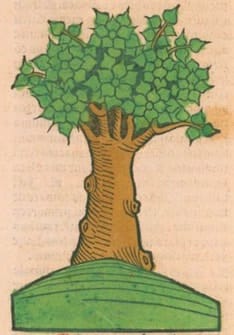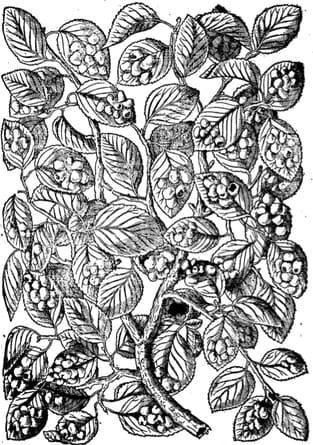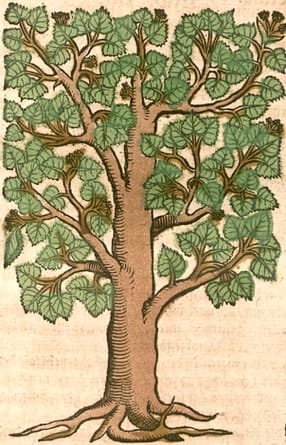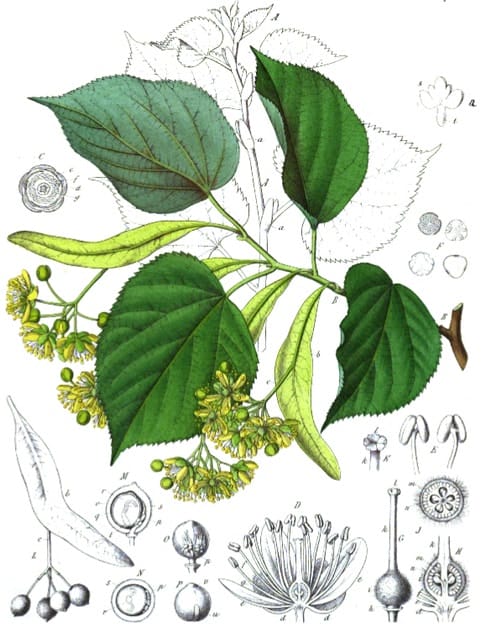Tilia, Linden
Lime flower, Tile tree, Tilia Ortus Sanitatis, Meydenbach, 1491
Ortus Sanitatis, Meydenbach, 1491
 New Kreuterbuch, Matthiolus, 1563
New Kreuterbuch, Matthiolus, 1563 |
 Krauterbuch, Lonitzer, 1578
Krauterbuch, Lonitzer, 1578 |
 Atlas der officinellen pflanzen, Felix, 1899
Atlas der officinellen pflanzen, Felix, 1899Botanical name:
Tilia europa
also T. vulgaris, T. cordata (Winter Linden), T. platyphylla (Summer Linden), T. intermedia and T. americana.
Male and Female types were listed in older herbals, but only the female has seeds and flowers.
Parts used:
Dried flowers with bracts, Leaf; rarely the bark or berries
Temperature & Taste:
Neutral, dry. Sweet, Pungent.
Classifications:
4a. CEPHALIC
Uses:
1. Clears Wind and Heat, Moves the Qi, Stops Spasms:
-Liver heat and wind-type Apoplexy, Epilepsy, Vertigo, Headaches, Migraine
-Palpitations, Hysteria, Spasms and Insomnia
-Arteriosclerosis; Hypertension, especially with anxiety or nervous tension; some consider it specific for this.
-calms the Mind, Spirit and Nerves, and helps release constrained Qi
-helps promote Menstruation when obstructed by Qi; also for PMS. (Leaf or Flowers)
2. Clears Wind and Heat, Promotes Sweat:
-acute Wind-Heat conditions with fever, restlessness and Headache as seen in feverish Colds, Influenza
-childhood Eruptive Fevers including Measles and Scarlet Fever.
-acute dry, hacking coughs with yellow sputum.
3. Clears Heat and Damp, Promotes Urine:
-high colored and foul-smelling Urine; acute UTI’s, Cystitis etc.
-auxiliary for Urinary Stones. (Bark, leaves)
4. Externally:
i. The leaves or flower are used in poultices for hot Swellings and Abscesses
ii. the bark was decocted and used as a wash for Burns and Scalds.
iii. The leaves were used as a gargle for red Sore Throats, often with a little Alum and Honey.
iv. Leaf or flowers is used externally as a wash for Itchy Skin Rashes.
BERRIES:
-‘The berries powdered are much commended for the Bloody Flux, and other Fluxes of the belly’ (Pechy)
-Diarrhea etc.
-Heat-type bleeding of the upper body associated with strong Liver heat rising.
LINDEN WOOD CHARCOAL:
-The charcoal from Linden wood has been used for Night Sweats, Spasmodic Coughs, and Fever, as well gastric acidity and gastric infections.
-used externally is good for Wounds and Burns.
Dose:
INFUSION or BRIEF DECOCTION of the LEAF: 3–9 grams;
FLOWER in INFUSION: 2–4 grams;
TINCTURE of the FLOWER (1:5 in 25% alcohol): 1–4 mls, 2–3 times daily;
DISTILLED WATER of the FLOWER: 1–2 oz.;
POWDER of LINDEN WOOD CHARCOAL: 1.5–4 grams, usually taken in milk.
Main Combinations:
1. Cold, Influenza from Wind-Heat:
i. Linden flower, Elder flower, Camomile
ii. Linden flower, Peppermint, Yarrow
2. Measles, Linden flower with Elder flower and Rosehip
3. Scarlet Fever and other eruptive Fevers, Linden flower, Rosehip, Blackberry leaf, Aniseed, Sloe flowers
4. Hypertension:
i. Linden flower, Hawthorn
ii. Linden flower, Balm, Mistletoe
iii. Linden flower, Nettle, Balm, Broom tops
iv. Linden flower, Yarrow, Peppermint, Camomile
5. Epilepsy, Linden flower, Nettle, Cherry tree leaf or flower; the distilled water of these was said to have cured a woman of Epilepsy. (The Practise of the New and old Phisicke, Gesner, 1599)
6. Apoplexy, Paralysis of the Tongue: flowers of Linden, Lily of the Valley, Peony, Cowslip, Lavender, Sage, Betony, Rosemary, with Mustard seed; this was fermented in water with hops and yeast added, and distilled to give a spirit. (Royal Chemist, 1670)
Major Formulas:
Antispasmodic Infusion
Cautions:
1. Avoid full doses during pregnancy
Main Preparations used:
Spirit, Distilled Water, Charcoal of the Wood
